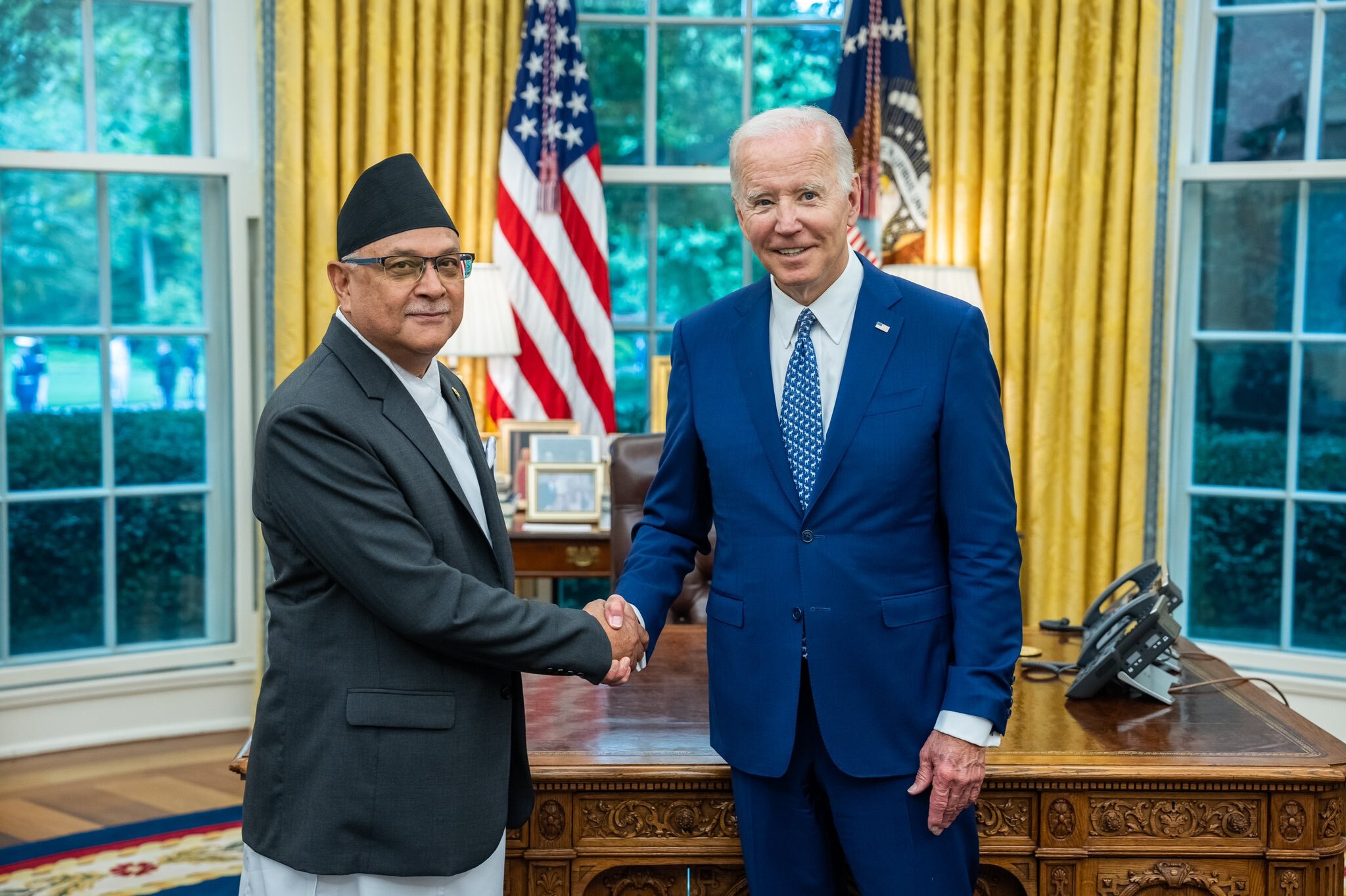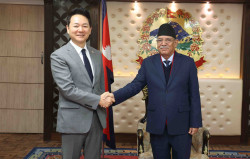Foreign Affairs

On June 13, 2022, Nepal’s envoy to the United States got a historic photo opportunity with the US President.
Officially released two weeks later, the photograph showed Nepali ambassador Sridhar Khatri firmly shaking hands with US President Joe Biden. Both were smiling for the camera.
The belatedly circulated photo was enough to leave many wondering: why did the Nepali embassy in Washington DC - or the Foreign Ministry in Kathmandu - take its sweet time to publicise the photograph showing two happy men briefly celebrating Nepal-US relations?
The Nepali embassy waited for weeks to decide on posting the photograph of the June-13 White House photo opportunity on Twitter. The reason is unclear.
In a tweet posted on June 27 about the photo-op, the Embassy said Ambassador Khatri and President Biden also had a “brief exchange of words on further strengthening Nepal-US bilateral relations,” which officially started on April 25, 1947.
Ambassador Khatri attended a photo-op session with President Joe Biden at the White House on 13 June 2022, during which they had a brief exchange of words on further strengthening Nepal-US bilateral relations. pic.twitter.com/eVfoJWyJwD
— Embassy of Nepal, Washington, D.C. (@nepalembassyusa) June 27, 2022

What that “brief exchange” covered is unclear either.
Interestingly, the official circulation of the photo coincided with the US visit of Nepali Army Chief General Prabhu Ram Sharma, who reached Washington on June 27 from Nepal’s UN peacekeepers’ bases in Lebanon and Syria. He was leading a five-member team, slated to visit several US Army facilities and the United Nations headquarters in New York, before ending his trip on July 1.
Anger over SPP
As the guesswork did its rounds on and off the social media, one thing was clear: On the day the ambassador attended the White House photo-op, much of Nepal was simmering with anger over reports that Nepali Army wished to join the US State Partnership Program (SPP) and forge deeper military relations with the US National Guards.
The hush about the photo-op started on the very day when many in Nepal - from the people on the streets and tea-shops to journalists, and from army generals to political leaders and parliamentarians - were intensely debating the pros and cons of Nepali Army joining the SPP.
Nepali Army’s participation in that programme, many feared, would have seen Nepali Army forging even closer partnership with the US military, participating in, among other things, activities like “joint training exercises in high altitude terrains of Nepal” and “joint disaster management and rescue exercises and operations in Nepal.”
Would any circulation of the photograph of a top-level US-Nepal handshake, on its very day or even the following day, that is, on June 13 or 14, have caused more trouble back home in Nepal? Or, would that have added fuel to the fire surrounding Nepali Army’s reported “eagerness” to join SPP?
Nepali politicians and army generals were not categorical, but a factsheet published by the US Embassy in Kathmandu on June 17 said that “Nepal asked to participate in the program (SPP) in 2015 and again in 2017”. After which, it added, “The US accepted its request in 2019,” and that “there is no proposed SPP agreement with Nepal”.
The US also maintained that SPP - which has existed in over 90 countries, mostly outside Asia Pacific - is “not an alliance of any kind like the Indo Pacific Alliance,” that it has “no connection whatsoever with MCC (Millennium Challenge Corporation)” Nepal Compact, which is a 500 million US dollars assistance programme that aims to build roads and electricity transmission lines across Nepal.
Coincidence
The same day – coincidentally, on June 17 - Foreign Minister Narayan Khadka and Nepali Army Chief Sharma, both having been summoned by the International Relations Committee of the House of Representatives, made it loud and clear before the MPs and journos that Nepal never intended to be part of any military alliance.
Then, Khadka urged everyone to “not stretch the matter any further”, thus effectively shelving the issue. Yet when more questions arose, ten days later, on June 27, Home Minister Balkrishna Khand repeated at the National Assembly, the upper house of Parliament, that Nepal did not want to join SPP, and that “the matter had already been communicated…”
A formality remains incomplete, though. Nepal is yet to send a formal letter to Washington saying it won’t go ahead with SPP - as the reported official speeches state.
Security experts, meanwhile, say SPP or no SPP, Nepali Army does have a long-standing – in fact, decades-long - military relations with US Army. Since 1980s, they say, members of the two armies have been holding joint military drills and trainings, mostly in the areas of post-disaster response.
Disaster response teams of the US Pacific Command – renamed US Indo Pacific Command on May 30, 2018 - headquartered in Hawaii, keep a close eye on 36 nations of the Indo Pacific region. Alongside military and police forces from neighbouring India, China and other countries, US Pacific command teams were among the first to arrive in Nepal for relief and rescue after the April 25, 2015 earthquake.
Nepali Army has been participating in similar joint military drills, exercises and trainings with the Indian Army and, of late, with the Chinese Army, as well. Nepali Army maintains special relations with the Indian Army, and the armies’ chiefs are mutually respected as “honorary generals.”
USA may be thousands of kilometres away, but Nepali Army General Sharma’s US visit this week has highlighted the strong ties that the US Army and the Nepali Army share.






